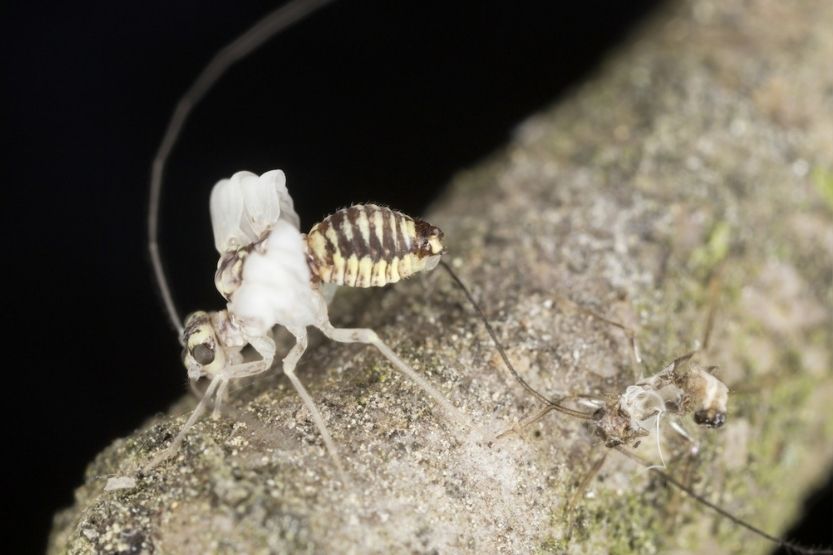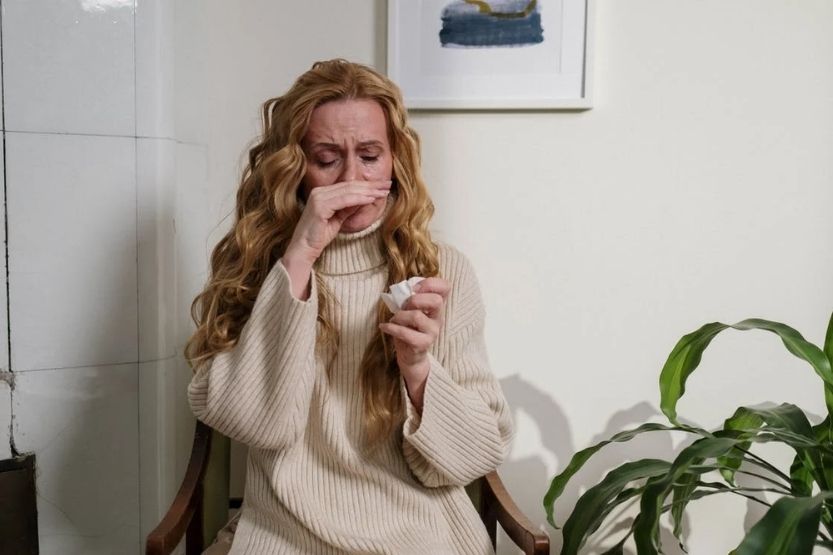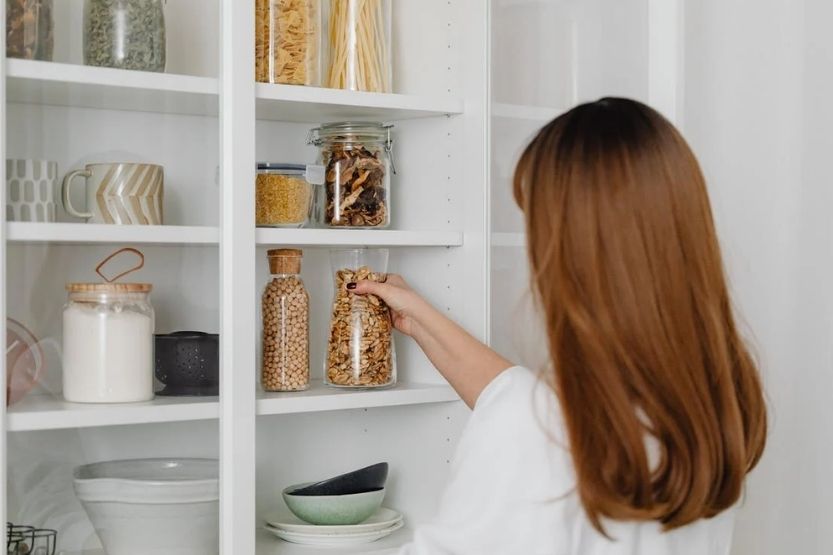The presence of tiny white bugs in the kitchen is a common issue many people face. You might see tiny white bugs in kitchen cabinets as small moving specks that look like flour or sugar. But even if you clean your entire house regularly, they seem to keep coming back! What exactly are these tiny white bugs, and how do you get rid of them?
Psocids and grain mites are the two most common types of tiny white bugs found in kitchens. Both bugs thrive in dark and moist environments where there’s little movement. Psocids feed on mold, while grain mites eat grains, cereals, and other dry goods. The back of your pantry is a favorite hiding place for them. And you’ll know you have an infestation when you notice brownish dust or your food smells or tastes funky.
Here’s what you should do to get rid of those pesky tiny white bugs in your kitchen:
- Clean and organize your kitchen pantry
- Throw out all infested goods
- Scrub your pantry clean with soap and water
Learn more about these tiny white bugs, including the best way to prevent them from infesting your home and what you can do to keep them from returning.
Tiny White Bugs in Kitchen

Identifying tiny white bugs found in and around your home is important before you start trying to get rid of them. You can find tiny white bugs anywhere, but some of the most common tiny white bugs include:
- Termites
- Clothes moths
- Psocids
- Grain mites
- Whiteflies
- Mealybugs
However, you won’t find all of these tiny bugs in your kitchen. Only grain mites and psocids are commonly seen in kitchens due to the ideal environment in which these two types of bugs thrive:
Psocids
Psocids (Psocoptera), more frequently referred to as bark lice, may grow indoors and outdoors. These bugs get their nickname because they are more commonly seen under tree barks. But after they’ve made their way into the house, they can be difficult to spot because they’re so tiny.
Where to Find Them?
They’re sometimes called booklice, but that’s a misnomer because they’re unrelated to lice and don’t thrive in books. Their primary food source appears to be bookbinding glue, so it’s possible to find them on or near books housed in damp shelving.
Psocids are prevalent and abundant bugs. However, they generally go unnoticed because of their tiny size.
You can find them outdoors in damp places, such as under bark, leaves, in the grass, and on damp wood. Also, they may become household pests by flourishing in damp areas of house basements and crawl spaces.
Characteristics and Behavior
Psocids are one of the tiniest creatures on the planet, measuring less than 3/16 inches with long, slender antennae. Their bodies are soft and oval-shaped, with no wings or a distinguishable head or tail. They are generally brown, white, or gray.
Psocids are often seen in tiny herds or groups on tree bark surfaces, where they feed on fungi, lichens, and other superficial plant materials. Their primary food source comes from even smaller molds that thrive in moist environments.
Grain Mites
Grain mites are most commonly found in kitchens and pantries. They feed on a wide variety of processed grains and cereals, including:
- Yeast,
- Flour,
- Wheat germ, and
- Cheeses.
Characteristics
Grain mites, also known as mold mites, are some of the tiniest bugs you can find, looking either grayish-white or pearly-white in color.
A magnifying glass will help reveal the long “hairs” found around their circular body. You could even mistake them for actual grains if you don’t pay close attention.
Grain mites usually prefer warmer temperatures around 20-27°C but will tolerate temperatures up to 35°C without much issue. Cold weather usually kills them off since they don’t live below 14°C.
Where to Find Them?
Grain mites are arachnids, like spiders and scorpions. You might have found them in any of the following places:
- Kitchen drawers,
- On top of the kitchen counters or fridge,
- In the pantry (usually towards the bottom), or
- Inside flour containers.
They feed on cereal and grains since it’s their preferred food source; however, they also like to scavenge for other small food such as pet hair. As a result, they often appear out of nowhere when you least expect it!
Grain mites prefer moist and humid environments, so these bugs can quickly multiply if your kitchen cabinets and main pantries are warm enough.
There can be up to 800 eggs laid by a female grain mite in her lifespan, contaminating your food supply. You’ll know when you find brownish residue called mite dust in kitchen cabinets and surfaces when you have grain mites.
If you see black bugs in your bathroom or black bugs in your kitchen, check out this article on Howchimp.com.
Are Tiny White Bugs in Kitchen Harmful to Humans and Pets?

Aside from a few exceptions, tiny white bugs spotted in and around your home are unlikely to threaten your health. Some people may have an allergic reaction similar to dust mite allergy when exposed to significant quantities of grain mites, particularly their residual brownish dust.
Allergic Reactions
Allergic reactions or symptoms include the following:
- Stuffy nose
- Sneezing
- Red, itchy, and watery eyes
- Itchy rashes
- Breathing difficulties
- Coughing
Are Psocids Harmless to Humans and Pets?
Psocids are harmless and don’t cause structural damage to buildings or spread disease. This means they’re unlikely to infest your whole home but rather stick around in the same room as their food source.
They don’t bite humans or pets or damage wood or furniture like carpenter ants do, so it’s not an issue if you have kids running around.
Psocids Eat Mold
Because psocids eat mold, simply keeping food storage areas clean and dry will take care of any infestations on their own — that is unless you have a severe mold issue that might need addressing by professionals.
Throw Grain Mite-infested Pet Food
You should throw grain mite-infested pet food as soon as possible. When pets ingest these tiny white bugs, they can suffer from allergic reactions, including diarrhea and inflammation of the intestines. It may also cause them to consume less food, resulting in stunted growth.
Grain mites are harmless to humans; however, some people may experience coughing or sneezing when exposed to large numbers.
Again, what are those tiny white bugs in the kitchen? These tiny, pearly-white or grayish-white bugs in the kitchen are probably grain mites. They usually prefer to live in moist places and feed on processed grains like yeast, flour, cereals, and even cheese.
How to Get Rid of Tiny White Bugs in Kitchen
Let’s be honest: whether these tiny white bugs in the kitchen pose a health risk or not, they are an inconvenience and can be a real pain due to their lightning-fast reproduction. You may only find a few today, but check back again tomorrow, and they’re all over your kitchen and other areas of the house! So, how can you get rid of these tiny white bugs?
Below are a few easy ways you can do if you want to get rid of tiny white crawling bugs in the kitchen (or the rest of your house):
1. Get Rid of Contaminated Food
If you find any contaminated food, throw it away immediately. This includes the entire box of cereal, pet food, and other food items. It’s critical that no one in the household, especially children or pets, consume infested food.
Foods like crackers and cereals that have been contaminated with grain mites may have a minty smell. Using contaminated flour for baked goods, such as bread, will produce a “muddy” taste.
2. Inspect Containers and Food Packages
Check each food product and container for possible contamination after finding tiny white bugs in your kitchen cabinets. This step may require the use of a magnifying glass. Remove all uncontaminated food from the area and store it safely and cleanly.
3. Use Warm Soapy Water When Cleaning Cupboards
You can use warm soapy water or diluted bleach solution to clean all cupboards and cabinets in the kitchen. To get rid of any tiny bugs, you need to use hot or warm water.
Ensure to rinse any sponge or cloth after each use to avoid spreading the bugs to other house areas. You can use half vinegar and half water as well.
4. Vacuum All Nooks and Crannies
Using a vacuum, thoroughly clean your pantry after the initial cleaning to remove any lingering psocids or grain mites. Make sure to empty the contents of the vacuum cleaner into outside waste bins together with some talcum powder to prevent the mites from reproducing.
As soon as everything has been cleaned and disinfected, you may begin restocking your pantry with uncontaminated food items.
5. Repeat the Process
You can clean all other areas of your kitchen in the same manner. Bugs may thrive even in the tiniest of spaces, including closets and bedside tables, so it’s good to check with kids to see whether they keep any food items in their rooms, such as cereal or crackers.
Tips to Prevent Bugs from Inhabiting Your Home

The best ways to keep tiny bugs out of your home are to keep them from getting inside in the first place. The following measures will help:
1. Keep Food Properly Stored
One of the biggest draws for bugs is leftover food, so make sure you’re storing it away and not on the countertop or near windows. If a product comes with its packaging, use that! Otherwise, seal up any open bags and containers as tightly as possible with an elastic band or a zipper.
2. Eliminate Clutter and Dampness
A cluttered and messy home is more than just an eyesore — it’s also a perfect breeding ground for tiny white bugs and pests, such as ants and cockroaches. Keep surfaces around sinks, ovens, washers, dryers, and other appliances clean and clear of debris that can build up over time.
Pay special attention to damp areas like bathrooms, basements, and crawlspaces where humidity levels can get too high, especially kitchen cupboards that have been exposed to water during dishwashing or cleaning, as dampness encourages bugs.
You’ll also want to frequently wipe down windowsills and ledges along with your kitchen cabinets — these are common areas for bugs to take up residence once they move into an infested home.
3. Clear Out Your Pantry
Don’t let your pantry get out of control. It’s important to periodically clear out your pantry and check for expired food items so you know what is going on and what needs to be thrown out. I like to do this once a month, but you can do it as often as you like — don’t forget!
FAQs – Tiny White Crawling Bugs in the Kitchen
What Are These Tiny Bugs in My Kitchen Cupboards?
Psocids and grain mites are common kitchen pests often found in pantries and dry food cupboards. These bugs thrive in dark and humid environments, making your kitchen cupboard the perfect breeding habitat.
Where Do Pantry Bugs Come From?
When contaminated grains or processed products are brought into a house, storage facility, or processing factory, they might cause an infestation. Infested food is the most common way pantry bugs enter homes. They can also enter through open windows and doors and small cracks in the wall.
How Do I Get Rid of Tiny White Bugs?
You can clean heavily infested areas with the help of hot water and insecticidal soaps. It is difficult for bugs to breathe when coated in insecticidal soap.
When it comes to your kitchen, vinegar is your best buddy. Using vinegar is another excellent way to get rid of tiny white bugs in the kitchen.
In addition to cleaning, vinegar also helps keep your house tidy. Mix half vinegar and half water in a clean container and apply or spray it directly to the problematic areas in your home. You can use diluted bleach as well.
Are Tiny White Bugs Harmful?
These tiny white bugs will not cause any direct harm to you or your family, including pets. They are more of an annoyance than a danger. Although these bugs won’t harm you, they are not exactly harmless.
To avoid drawing tiny white bugs into your kitchen, seal off any cracks or crevices that form from your wall or floor. Also, patch any holes in your countertops to keep these small bugs away.
Conclusion – Tiny White Kitchen Bugs
Having a well-kept kitchen is a sign of a healthy household. It’s a good idea to keep an eye out for tiny white bugs lurking in the dark and humid crevices of your kitchen cupboards and cabinets. The first step in keeping your kitchen pest-free and clean is to know what you’re dealing with.
Many bugs can be found in your home, including psocids and grain mites, which prefer to live in your kitchen. Despite their tiny size and minimal damaging effects on humans and pets, these bugs can be nuisances.
How to Recognize Tiny White Bugs?
Here’s a quick guide on how to spot these tiny white bugs and know whether or not your food is contaminated:
- Grain mites leave behind a brownish trail of dust for both humans and pets.
- If the food is contaminated, it may smell minty, uncommon for dry grains.
- If you use contaminated flour, cooked food may taste muddy. You may be able to get rid of the bugs when you cook the food, but you won’t be able to get rid of the weird taste that comes with it.
How to Get Rid of Tiny White Bugs?
Tips to get rid of tiny white bugs in your kitchen and other areas:
- You should throw all expired and contaminated food items out of your kitchen pantry.
- It’s important to wash all surfaces thoroughly with hot or warm soapy water and dry the rag between uses. A thorough vacuuming will ensure that no bugs will be left to reproduce in your pantry again.
- Use a humidifier, make sure your pantry is well-lit, and sprinkle talcum powder in non-food locations to dry them and prevent mold from growing.
- Consider storing any food in airtight containers to prevent moisture from leaking in. Besides making your kitchen look better, it can also help reduce the likelihood of another pest infestation in your house.
When it comes to keeping your kitchen clean, there are no hard and fast rules. There are cleaning products and tools for any bug infestation or other problems you may have in your home.
Regularly cleaning your kitchen is the best way to keep it clear of these tiny white bugs. Pests are drawn even on the underside of kitchen counters, which can store food and house water pipes. They are attracted to these locations because they are moist and humid.
Preventing further infestations in your kitchen can be as simple as making a few changes to the way things are organized in your kitchen.
Read next:
Little Black Bugs In House – What Are They? (With Pictures)
Tiny Black Bugs in Bathroom [What Are They? How to Get Rid of Them?]

![Tiny Black Bugs in Bathroom [What Are They? How to Get Rid of Them?] tiny black bug in bathroom](https://howchimp.com/wp-content/uploads/2021/05/tiny-black-bug-in-bathrooms-6-300x200.jpeg)


